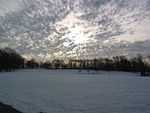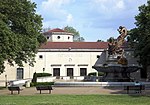Phipps Conservatory and Botanical Gardens

Phipps Conservatory and Botanical Gardens is a botanical garden set in Schenley Park, Pittsburgh, Pennsylvania, United States. It is a City of Pittsburgh historic landmark and is listed on the National Register of Historic Places.The gardens were founded in 1893 by steel and real-estate magnate Henry Phipps as a gift to the City of Pittsburgh. Its purpose is to educate and entertain the people of Pittsburgh with formal gardens (Roman, English, etc.) and various species of exotic plants (palm trees, succulents, bonsai, orchids, etc.). Currently, the facilities house elaborate gardens within the fourteen room conservatory itself and on the adjoining grounds. In addition to its primary flora exhibits, the sophisticated glass and metalwork of the Lord & Burnham conservatory offers an interesting example of Victorian greenhouse architecture. Phipps is one of the "greenest" facilities in the world. The entrance pavilion of the Phipps Conservatory has silver-level LEED certification. Its greenhouse production facility has received Platinum certification, the first and only greenhouse to be so certified. Moreover, the Center for Sustainable Landscapes, designed to be as environmentally sustainable as possible, is also LEED Platinum certified, and produces all of its own energy.
Excerpt from the Wikipedia article Phipps Conservatory and Botanical Gardens (License: CC BY-SA 3.0, Authors, Images).Phipps Conservatory and Botanical Gardens
Frew Street Extension, Pittsburgh
Geographical coordinates (GPS) Address Nearby Places Show on map
Geographical coordinates (GPS)
| Latitude | Longitude |
|---|---|
| N 40.438948 ° | E -79.947705 ° |
Address
Phipps Conservatory
Frew Street Extension
15213 Pittsburgh
Pennsylvania, United States
Open on Google Maps








